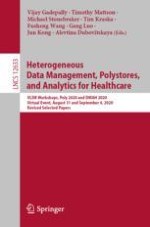2021 | OriginalPaper | Chapter
Enhancing Medical Word Sense Inventories Using Word Sense Induction: A Preliminary Study
Authors : Qifei Dong, Yue Wang
Published in: Heterogeneous Data Management, Polystores, and Analytics for Healthcare
Publisher: Springer International Publishing
Activate our intelligent search to find suitable subject content or patents.
Select sections of text to find matching patents with Artificial Intelligence. powered by
Select sections of text to find additional relevant content using AI-assisted search. powered by
